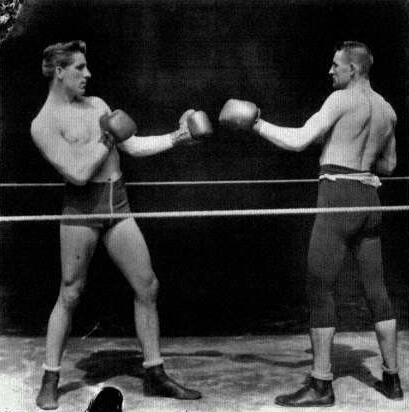Corbett and Courtney Before the Kinetograph (partially found early boxing film; 1894)
On 7th September 1894, professional boxers James L. Corbett and Peter Courtney competed in an exhibition match, Corbett ultimately winning after six rounds via a KO. Promoted as Corbett and Courtney Before the Kinetograph, it was the second ever boxing event to be filmed and one of the most commercially successful films of the Kinetoscope era.
Background
Heading into the bout, "Gentleman" James L. Corbett was one of boxing's biggest stars.[1][2][3] With a height of 6′1.50″, and weighing between 173-190 lbs, Corbett's scientific approach and fancy footwork led to a successful career, handing John L. Sullivan his only ever loss to claim the World Heavyweight Championship.[4][5][1][3][2] He was therefore the favourite against the relatively unknown New Jersey boxer Peter Courtney.[6][4][5]
Earlier in 1894, the Edison Manufacturing Company commercially released the first ever sports film with the Leonard-Cushing Fight on 4th August.[4][5][3] However, that boxing film was not commercially successful, primarily because neither Mike Leonard nor Jack Cushing were well-known outside of Brooklyn.[4][5] Therefore, the Latham brothers required a bigger star to attract the mainstream.[4][5] After rumoured negotiations with Sullivan came to nothing, a deal was struck between the Kinetoscope Exhibiting Company (which worked to film prizefights on behalf of Edison) and Corbett to star in the next film.[4][5][3] What made the deal especially lucrative was that between 1893-1894, Corbett had only defended his World Championship once, defeating Charlie Mitchell in January 1894.[4][5][2] Further adding to the film's potential success was Corbett's experience on stage, having starred in a play based on his life called Gentleman Jack.[3][4][2]
The Fight
The Lathams had hoped to promote a $15,000 rematch between Corbett and West Indian boxer Peter Jackson, the pair having achieved a sixty-one round draw on 21st May 1891.[1][4][5][2] However, Corbett refused, insisting that the "color line" be respected when it came to matches featuring the World Champion.[5][4] Corbett also rejected a match against Robert Fitzsimmons, forcing the Lathams to select Courtney, who reportedly had put up a decent fight against Fitzsimmons in early-1894.[4][5] The fight took place on 7th September 1894, at Edison's Black Maria studio in New Jersey.[7][4][3][5][2] Like with the Leonard-Cushing Fight, the bout was not legitimate despite several journalists claiming it as such.[3][4][7] Throughout the contest, Corbett had no real concerns against Courtney, easily blocking his foe's attacks and taking the whole encounter with great humour.[4][5][7] Ultimately, with Courtney on the back foot and seemingly accepting defeat, Corbett secured the victory in the sixth round by KO.[5][4][2][3][7] For his role, Corbett earned $4,750 and $150 weekly in film royalties, while Courtney was paid $1,000.[5][3]
The recording was directed by William Kennedy Dickson and filmed by William Heise.[5][7] Unlike the Leonard-Cushing Fight, the Corbett-Courtney bout, titled as Corbett and Courtney Before the Kinetograph, proved a major financial success following its official release on 17th November 1894.[4][5][7] A few factors for the film's success included Corbett's fame, how most reporters did not denounce the fight as fake, and also for the controversy surrounding the encounter possibly being a prizefight, illegal in New Jersey at the time.[4][5] But like with the Leonard-Cushing Fight, Edison and co. escaped possible charges, despite a Judge ordering a grand-jury investigation into the bout.[4][5] Alas, Fight Pictures and A History of Sports Highlights note the controversy may have further enticed people to view the film, which was split into six recordings.[4][5][7][3] The fight remained popular well into 1897, making it one of the most successful films of the Kinetoscope era.[4][5] Corbett continued boxing, dropping the World Heavyweight Championship to Fitzsimmons on 17th March 1897, in a filmed encounter titled The Corbett-Fitzsimmons Fight.[3] Retiring in 1903, he capitalised on his early stage experience to act in several films from the 1910s to the late-1920s.[3] Meanwhile, Courtney fought in at least four more encounters, before passing away on 11th May 1896.[6]
Availability
According to the June 1887 issue of the F.M. Prescot Catalogue, each round of the bout was recorded and listed separately, with each around 150 feet long.[7] This means the film's full size was around the 900 feet mark. Ultimately, the majority of Corbett and Courtney Before the Kinetograph has been lost to time, with the decision to split the film into six parts worsening the recording's chances of being preserved.[4][5][7] As of modern times, just eight seconds of match footage has resurfaced.[7]
Gallery
Video
See Also
- Heavyweight Champ (lost SEGA arcade boxing game; 1976)
- Jack Dempsey vs Billy Miske (lost radio report of boxing match; 1920)
- Leonard-Cushing Fight (partially found early boxing film; 1894)
- Rocky (lost deleted scenes of boxing drama film; 1976)
- Uncle Slam and Uncle Slam Vice Squad (lost iOS presidential boxing games; 2011)
References
- ↑ 1.0 1.1 1.2 The Fight City providing a detailed account of Corbett's main matches. Retrieved 13th Dec '22
- ↑ 2.0 2.1 2.2 2.3 2.4 2.5 2.6 Cyber Boxing Zone summarising the career of James L. Corbett and his known fights. Retrieved 13th Dec '22
- ↑ 3.00 3.01 3.02 3.03 3.04 3.05 3.06 3.07 3.08 3.09 3.10 3.11 Archived Who's Who of Victorian Cinema detailing the boxing and filming career of Corbett. Retrieved 13th Dec '22
- ↑ 4.00 4.01 4.02 4.03 4.04 4.05 4.06 4.07 4.08 4.09 4.10 4.11 4.12 4.13 4.14 4.15 4.16 4.17 4.18 4.19 4.20 Fight Pictures detailing the filming of the bout. Retrieved 13th Dec '22
- ↑ 5.00 5.01 5.02 5.03 5.04 5.05 5.06 5.07 5.08 5.09 5.10 5.11 5.12 5.13 5.14 5.15 5.16 5.17 5.18 5.19 5.20 A History of Sports Highlights detailing the encounter and providing several reviews of it. Retrieved 13th Dec '22
- ↑ 6.0 6.1 Fights Rec page on Peter Courtney. Retrieved 13th Dec '22
- ↑ 7.0 7.1 7.2 7.3 7.4 7.5 7.6 7.7 7.8 7.9 Library of Congress detailing Corbett and Courtney Before the Kinetograph. Retrieved 13th Dec '22
